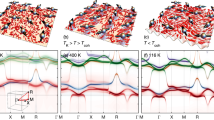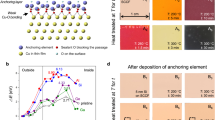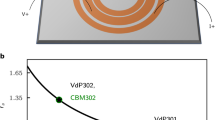Abstract
AT sufficiently low temperatures and high frequencies, the mean free path of the electrons in a good conductor becomes greater than the classically predicted skin depth, and the classical skin-effect equations break down. Pippard1 has studied the effect at liquid helium and liquid hydrogen temperatures, and Reuter and Sondheimer2 have given the quantitative theory of the effect, and have interpreted Pippard's results. They found that for tin, mercury and aluminium, the experimental results implied reasonable values for the ratio σ/l of conductivity to electronic mean free path, but that for copper, silver and gold they implied values lower than the expected values by a factor of 5 or more. It was suggested that these low values were due to surface conditions differing from those in the bulk metal. In order to study this suggestion and to make a more detailed comparison with the theory than was possible on the basis of Pippard's measurements, a new investigation has been carried out in which attention has been paid to surface conditions, and the whole temperature range from 2° K. to 90° K. has been covered.
This is a preview of subscription content, access via your institution
Access options
Subscribe to this journal
Receive 51 print issues and online access
$199.00 per year
only $3.90 per issue
Buy this article
- Purchase on SpringerLink
- Instant access to full article PDF
Prices may be subject to local taxes which are calculated during checkout
Similar content being viewed by others
References
Pippard, A. B., Proc. Roy. Soc., A, 191, 385 (1947).
Reuter, G. E. H., and Sondheimer, E. H., Proc. Roy. Soc., A, 195, 336 (1948).
Author information
Authors and Affiliations
Rights and permissions
About this article
Cite this article
CHAMBERS, R. Anomalous Skin Effect in Metals. Nature 165, 239–240 (1950). https://doi.org/10.1038/165239b0
Issue date:
DOI: https://doi.org/10.1038/165239b0
This article is cited by
-
Electrokinetic effects in liquid mercury
Soviet Atomic Energy (1963)
-
Die Temperaturabh�ngigkeit des Reflexionsverm�gens von Cu, Ag, Au, Al und Ni
Zeitschrift f�r Physik (1956)
-
Bestimmung der mittleren freien Wegl�nge der Leitungselektronen in Kalium
Zeitschrift f�r Physik (1955)



